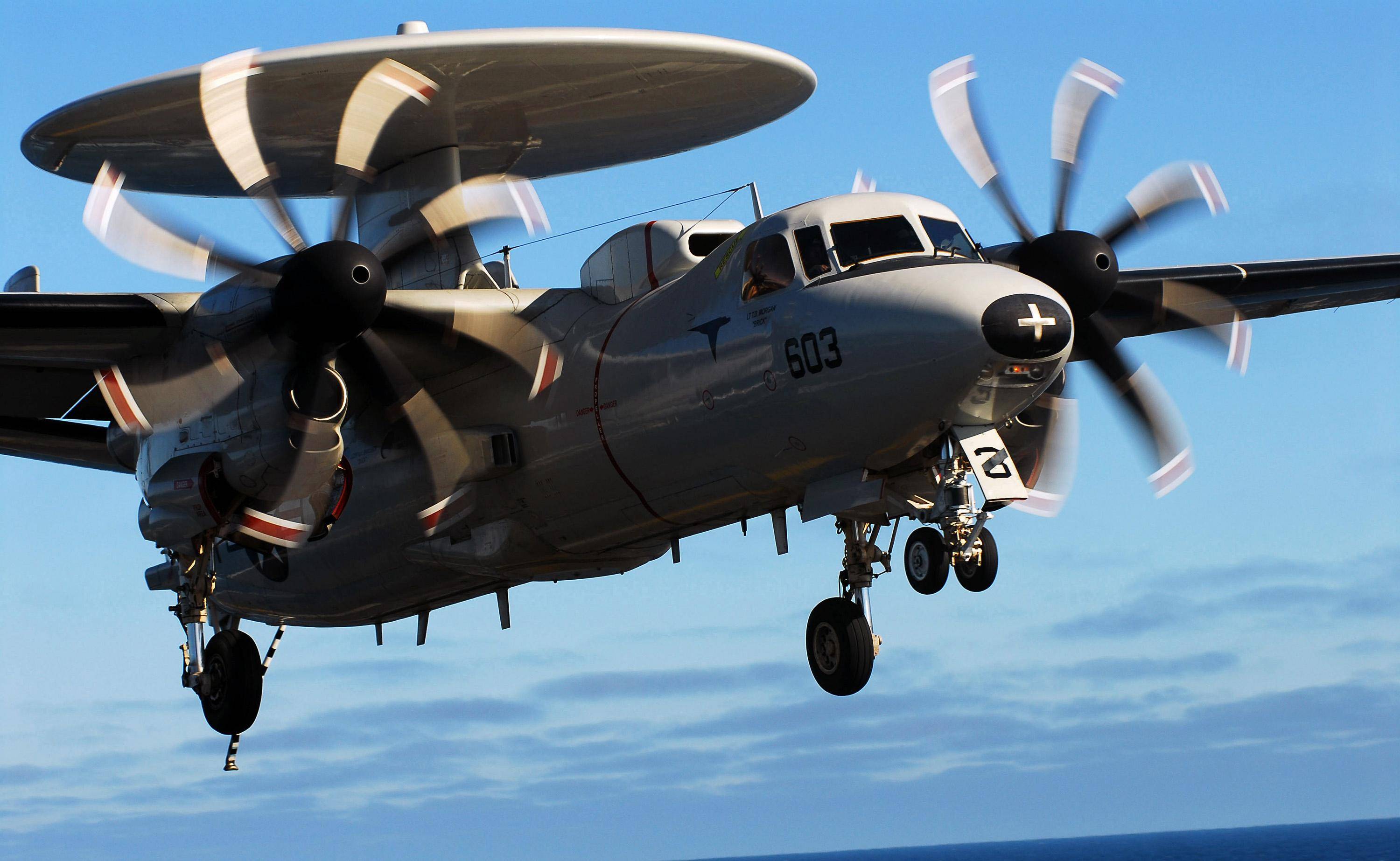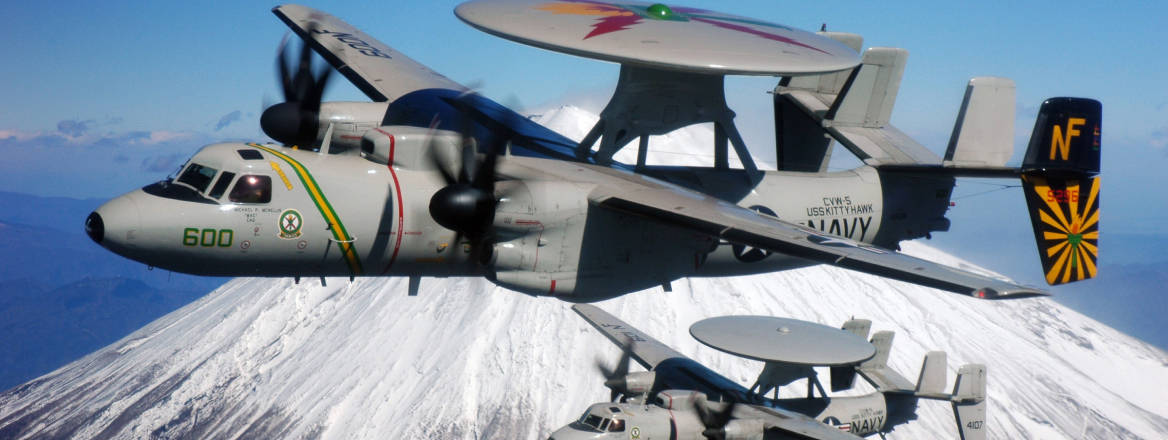A recent deployment of new US assets in the Pacific could represent a significant capability boost in countering improving Chinese missile and aircraft technology.
Tensions between the US and, respectively, China and North Korea, have prompted the US to regularly rotate prestigious aerial combat assets such as F-22 Raptor fighters and B-52 bombers into the Asia-Pacific theatre. This sends signals to both allies and rivals about US military capabilities and resolve.
Washington announced earlier this month that the US Navy will, in a matter of weeks, deploy its Carrier Airborne Early Warning Squadron (VAW) 125 to Iwakuni Air Base in Japan with its E-2D Hawkeye aircraft – replacing VAW 115 with its E-2Cs. The move did not necessarily attract media attention, but it is nonetheless a highly significant signal of US posture in the region.
The E-2 Hawkeye is an aircraft carrier-capable equivalent to the US Air Force’s iconic E-3 Sentry, known to the world as AWACS.
Like the E-3, the Hawkeye carries communications arrays and mounts a large radar dish on top of its fuselage. It has banks of workstations so that aircrew can provide real-time processing, exploitation and dissemination of the battlespace picture that the radar provides for fleet early-warning.
This also provides aerial command and control services to other aircraft, and acts as a data-relay and translation hub between different maritime and air platforms. In simple terms, the E-2 Hawkeye is the airborne eyes and ears of the US Navy.
The importance of the deployment announced earlier this month is the fact that the VAW 125 squadron is equipped with the newest version of the Hawkeye – the E-2D. Compared with the E-2C which it is replacing in the US Navy’s Japan-based Carrier Air Wing 5, the E-2D has many operational advantages that are specifically relevant to a range of new Chinese military capability developments.
The most significant difference between the externally similar-looking aircraft is the replacement of the older mechanically scanning radar with the new A/N-APY9 radar. This is an ultra-high frequency band radar capable of both electronic scanning and mechanical scanning in order to combine the detection advantages of both techniques against particular target types and cancel out the disadvantages.
The radar itself is not only modern, frequency-agile and powerful, but it feeds a formidable latest-generation mission system capable of weeding out false positives, combining and cross-referencing data from different frequency scans and other clever software-enabled tricks.
This enables operators to get a much clearer and more unambiguous situational awareness picture than human-dependent processing of the basic scan outputs could possibly yield alone.

What all this means is that the E-2D is a huge leap forward for the US Navy in terms of detection, tracking and target engagement capabilities at long range against two specific target sets that are very hard for traditional mechanically scanned radars to detect or track accurately.
The first target set are fighter-sized combat aircraft utilising low-observable or ‘stealth’ airframe shaping and coatings to hide from more traditional arrays – an area where China is racing to catch up with US capabilities with its J-20 and J-31 fighters, and secretive Lijian ‘Sharp Sword’ low-observable unmanned combat aerial vehicle.
The J-20 in particular has long range on internal fuel and impressive internal weapons bays that are thought to be capable of carrying anti-ship missiles.
Early detection of such threats will be crucial to maintaining the survivability of US Navy surface warships in any future conflict with China. The E-2D is certainly more capable than any other currently operational US early warning aircraft of detecting such threats at long range.
Likewise, the A/N-APY9 radar is thought to offer significantly improved detection and (crucially) tracking capabilities against small, high-supersonic and hypersonic threats such as cruise missiles and ballistic missile warheads.
Given the proliferation of supersonic anti-ship cruise missiles and the potentially revolutionary Chinese DF-21D anti-ship ballistic missile, the ability to provide both early warning and over-the-horizon target-tracking grade data to the fleet is likely to be essential for the US Navy’s carrier battlegroups, to be able to operate within a Chinese anti-access/area denial (A2/AD) zone in future.
The E-2D cannot engage and destroy incoming threats itself, but instead relays target information to both friendly aircraft and ships which carry missiles capable of conducting an interception.
Therefore, the upgrade from E-2C to E-2D in Japan – carried out before many of the US Navy’s other CVWs have transitioned - shows that the US Navy is determined to enhance fleet survivability and lethality in the Asia-Pacific, and regards this as a matter of priority.
Overall, the E-2D will be a cornerstone of the Naval Integrated Fire Control – Counter Air strategy being pursued in response to improving Chinese missile and aircraft technology in the Pacific.
With its enhanced spectrum of capabilities, the E-2D should provide a significant survivability and lethality boost to every strike fighter and Aegis ship in the US fleet.
It allows other assets to engage and defend against threats which otherwise they would be unable to detect (at least detect in time) using their own sensors.
This deployment of the visually unassuming, propeller-driven, unarmed early-warning aircraft to Japan (as well as the sale of the E-2D to the Japanese Self-Defence Forces), represents the start of a significant growth in the combat flexibility of US and allied naval forces in the Asia-Pacific, and a direct response to Chinese A2/AD threat technology developments.
WRITTEN BY
Justin Bronk
Senior Research Fellow, Airpower & Technology
Military Sciences


